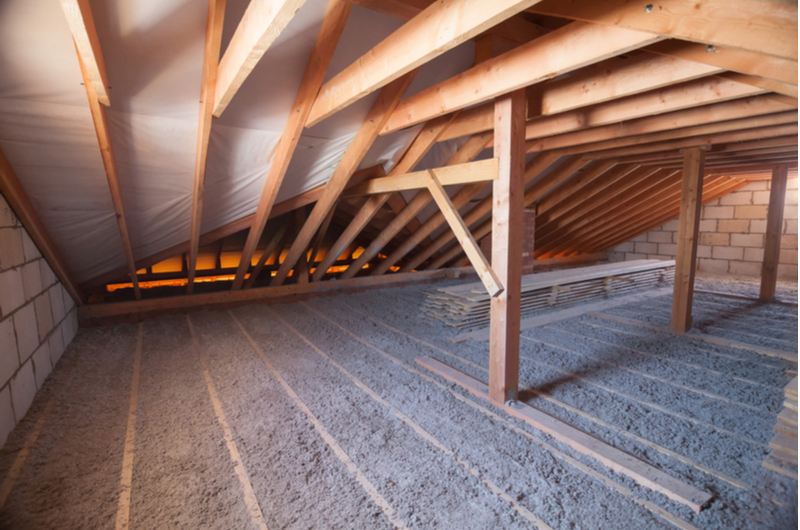Insulation allows you to control the heat flow in your home. Discover
different methods and materials to insulate your home.
Insulation slows the movement of heat in your home. It also absorbs some of the heat, allowing you to keep your house warm. No matter where you live, heat always goes from the warmest to coldest part of the house. When you insulate your home, the heat is evenly spread out throughout the house, so you do not experience drastic temperature changes from room to room.
In addition to keeping your home warmer, there are practical benefits
to installing insulation in your home. Using insulation cuts down on your monthly bills, since you do
not need to run your heaters as frequently. This also has a positive effect on the environment since
your home uses less electricity. There are even energy rebates available if you install insulation in
your home. The overall value of your home also increases, since insulated houses are more appealing to
buyers. 
Spray Foam Insulation
Spray foam insulation is commonly used on either unfinished walls or concrete slabs, where there is limited space to apply any other insulation. Once you spray the foam onto the surface of the wall, it gradually expands and slowly hardens into a solid foam. It is best used to fill smaller spaces, or to seal up leaks or gaps along a wall. Larger projects are possible, but you are strongly advised to hire a professional to apply the foam. This is because it is difficult to measure the exact amount to use.
Professionals also know the best conditions to apply the foam. Each foam does better at a certain temperature. If it is too hot, the foam shrinks and will not properly insulate your wall. Additionally, if the foam is exposed to sunlight, it can even release toxic fumes.
There are three categories of spray foam, high, medium, and low density. High density foam is primarily used on the roof, as it provides the greatest protection against air and water, while keeping the heat from escaping your house. Medium density is good for areas that require continuous insulation inside your home, such as an attic or basement. Low density is used for the general interior of your home. Spray foam typically costs between $1.50 to $3.00 per square foot, depending on the brand.
Blown-in Insulation
Blown-in insulation does not refer to a specific material, but a technique to insulate the inside of your walls. With blown-in insulation, you use a specialized machine to blow insulation into your walls. Using an attached hose, you are able to reach isolated spots in your wall without having to tear apart your house. There are many types of insulation you can use with blown-in insulation. The most common is a mixture of fiberglass or rock wool. You can also use reclaimed cellulose, made of recycled newspaper or cardboard.
Insulation blowers are expensive, with the cheapest models costing several hundred dollars. Fortunately, many stores allow you to rent a blower for a reduced rate. If you are not comfortable operating the blower, you can hire a professional instead.
Foam Boards and Panels
A common type of insulation is foam boards and panels. This is one of the most affordable insulation methods, but it is easiest to install when you have unfinished walls. The boards reduce the amount of heat conducted by the wood and studs within your walls, allowing the heat to disperse through the rest of your house. If you are building a new home or making renovations to an existing one, talk to your contractor about installing foam boards and panels as part of the construction. Most contractors are willing to add the boards for a minimal cost since they require minimal effort to install on unfinished walls.
Rmax sells multiple polyiso foam board packages, which include specialized construction and seal tape to secure the boards. They have separate boards for walls, roofs, and foundation. There are also custom boards for unique shapes, such as cathedral style ceilings or crawl spaces.
Another brand of foam panels is Cellofoam. Cellofoam uses polystyrene foam boards. Polystyrene is a highly durable material, which does not deteriorate with age. It is also moisture resistant, preventing mold or mildew from growing inside of the walls. Cellofoam also sells EPS panels, which not only insulate your home, but also reduce sound and air movement.
Blanket Batts and Rolls
Blanket Batts and Rolls are most commonly made from fiberglass, but there are other variants using cotton, mineral wool and plastic fibers. It is the least expensive insulating material and easy to install on your own. Most blankets and rolls cost under $1 per square foot. If you use a fiberglass variant, make sure to wear protective materials, including a face mask. If you purchase rolls of insulation, you must measure and cut the insulation yourself.
Radiant Barriers
Radiant barriers, sometimes referred to as reflective barriers, are intended for warm weather climates, where you want to reduce the amount of heat in your home. Instead of allowing more heat to freely flow in your home, the reflectors direct heat away from your home. Radiant barriers are typically placed at the top of the house since this is where most heat enters the home. The panels are easy to install, but if you have a uniquely shaped roof you may need to hire a professional to secure the panels in place. Radiant barriers are typically sold as larger units, ranging between $150 to $400, depending on the size.